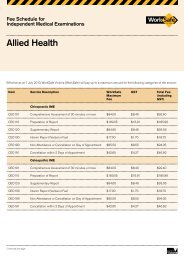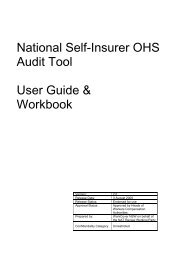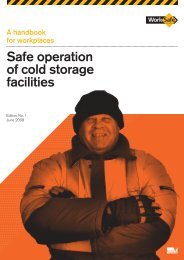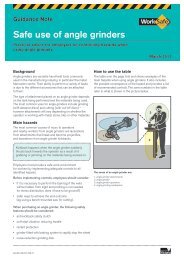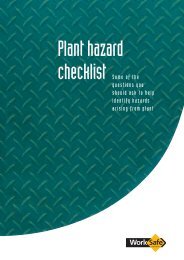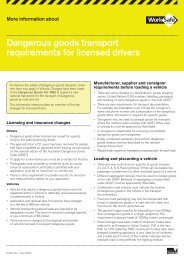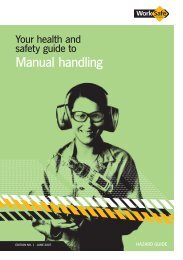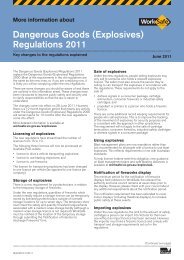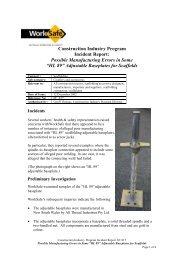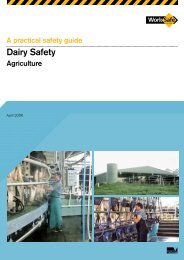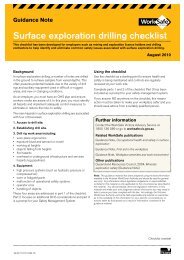For Managing chemicals in the Workplace ... - WorkSafe Victoria
For Managing chemicals in the Workplace ... - WorkSafe Victoria
For Managing chemicals in the Workplace ... - WorkSafe Victoria
You also want an ePaper? Increase the reach of your titles
YUMPU automatically turns print PDFs into web optimized ePapers that Google loves.
A step by step guide formanag<strong>in</strong>g <strong>chemicals</strong><strong>in</strong> <strong>the</strong> workplace
© 2001 <strong>Victoria</strong>n WorkCover Authority<strong>Victoria</strong>n WorkCover AuthorityLevel 24, 222 Exhibition Street, Melbourne, Vic 3000GPO Box 4306, Melbourne, Vic 3001Tel: 03 9641 1555, Fax: 03 9641 1222, Toll free: 1800 136 089Website: www.workcover.vic.gov.auEmail: Info@workcover.vic.gov.auAcknowledgmentsThanks to <strong>the</strong> to <strong>the</strong> follow<strong>in</strong>g members of <strong>the</strong> Stakeholder Liaison Group of <strong>the</strong> <strong>Victoria</strong>n WorkCover Authority’sHazardous Substances Legislation Implementation Project for <strong>the</strong>ir support, advice and guidance on <strong>the</strong>development of this publication:Australian Industry Group (AIG) - Sandra Cowell, Susan Rob<strong>in</strong>sonAustralian Manufactur<strong>in</strong>g Workers Union (AMWU) - Deborah Vallance, Sarah Ross<strong>Victoria</strong>n Trades Hall Council (VTHC) – Mark Towler, Cathy Butcher, Margot HoyteNational Union of Workers (NUW) - Gayle BurmeisterPlastics and Chemicals Industry Association (PACIA) - Greg Oldfield, Ian Swann<strong>Victoria</strong>n Employers’ Chamber of Commerce and Industry (VECCI) - Gary ThompsonThis publication is based on <strong>the</strong> follow<strong>in</strong>g source material:Occupational Health and Safety (Hazardous Substances) Regulations 1999 (Vic)Code of Practice for Hazardous Substances, No. 24, 1 June 2000 (Vic)Dangerous Goods (Storage and Handl<strong>in</strong>g) Regulations 2000 (Vic)Code of Practice for <strong>the</strong> Storage and Handl<strong>in</strong>g of Dangerous Goods, No. 27, 8 December 2000 (Vic)<strong>Manag<strong>in</strong>g</strong> chemical hazards <strong>in</strong> <strong>the</strong> workplace: Advice for managers and supervisors, April 1996, WorkCover NSW
* NEW Dangerous Goods (Storage and Handl<strong>in</strong>g) Regulations 2012On 1 December 2012, <strong>the</strong> Dangerous Goods (Storage and Handl<strong>in</strong>g) Regulations2012 (DG (S&H) Regulations 2012) replaced <strong>the</strong> Dangerous Goods (Storageand Handl<strong>in</strong>g) Interim Regulations 2011 (Interim Regulations) which expired onthis date. The DG (S&H) Regulations 2012 have reta<strong>in</strong>ed most of <strong>the</strong> legalrequirements conta<strong>in</strong>ed <strong>in</strong> <strong>the</strong> Interim Regulations. There are only a small numberof changes. This document has not yet been updated to reflect <strong>the</strong> changes<strong>in</strong>troduced by <strong>the</strong> DG (S&H) Regulations 2012. More <strong>in</strong>formation on <strong>the</strong> keychanges <strong>in</strong>troduced by <strong>the</strong>se new regulations can be found <strong>in</strong> <strong>the</strong> guidance titledInformation about: Key changes to dangerous goods storage and handl<strong>in</strong>grequirements and More <strong>in</strong>formation about: Incident report<strong>in</strong>g.
IntroductionThe purpose of this guide is to help employers to manage <strong>chemicals</strong> safely, and <strong>in</strong> do<strong>in</strong>g soto comply with <strong>the</strong> relevant aspects of <strong>the</strong> <strong>Victoria</strong>n Occupational Health and Safety(Hazardous Substances) Regulations 1999 and <strong>the</strong> Dangerous Goods (Storage and Handl<strong>in</strong>g)Regulations 2000. Dangerous goods that are considered explosives are covered by separateregulations. Specific requirements that apply to explosives are not covered <strong>in</strong> this booklet.The comb<strong>in</strong>ed aim of <strong>the</strong> Occupational Health and Safety (Hazardous Substances) Regulationsand <strong>the</strong> Dangerous Goods (Storage and Handl<strong>in</strong>g) Regulations is to protect people andproperty from risks associated with <strong>the</strong> use and storage of <strong>chemicals</strong>. To achieve this, <strong>the</strong>regulations impose duties on manufacturers, importers, suppliers and employers deal<strong>in</strong>gwith hazardous substances and dangerous goods. A summary of <strong>the</strong> duties is outl<strong>in</strong>ed <strong>in</strong>this guide. Approved codes of practice for both regulations are also available to helpvarious parties to understand <strong>the</strong> regulatory requirements and comply with <strong>the</strong>m. As thisdocument is only <strong>in</strong>tended as a guide, reference should be made to <strong>the</strong> regulations<strong>the</strong>mselves if <strong>the</strong>re is uncerta<strong>in</strong>ty about particular legal requirements.This booklet suggests ways <strong>in</strong> which you can manage <strong>the</strong> hazards and risks posed by <strong>the</strong>use of <strong>chemicals</strong> classified as hazardous and/or dangerous goods. Many substances areclassified as both hazardous substances and dangerous goods. In <strong>the</strong>se cases, both regulationsapply and should be considered at <strong>the</strong> same time. Employers who manufacture, import andsupply <strong>chemicals</strong> to workplaces should also refer to <strong>the</strong> booklet titled A step by step guidefor manufacturers, importers and suppliers of hazardous substances and dangerous goodsproduced by <strong>WorkSafe</strong> <strong>Victoria</strong>.<strong>Manag<strong>in</strong>g</strong> <strong>chemicals</strong> safely requires consultation, commitment and resources <strong>in</strong> <strong>the</strong> form offunds, people and time. To undertake <strong>the</strong> tasks outl<strong>in</strong>ed <strong>in</strong> this booklet and to achieve a safeworkplace <strong>in</strong> relation to <strong>chemicals</strong>, you will need to provide adequate resources, and<strong>in</strong>volve employees and health and safety representatives throughout <strong>the</strong> process.
Suppliers (exclud<strong>in</strong>g retailers or retail warehouse operators) are required to:• provide a current MSDS to any person to whom hazardous substances or dangerousgoods are supplied for use at a workplace and to any employer on request• ensure conta<strong>in</strong>ers <strong>in</strong> which substances are supplied are labelled/marked with <strong>the</strong>manufacturer’s or importer’s label• ensure conta<strong>in</strong>ers of dangerous goods do not, or will not, leak and that <strong>the</strong> dangerousgoods are <strong>in</strong> good condition.What are <strong>the</strong> key duties of employers?The Occupational Health and Safety (Hazardous Substances) Regulations 1999 and <strong>the</strong>Dangerous Goods (Storage and Handl<strong>in</strong>g) Regulations 2000 require employers (occupiers) to:• ensure that prohibited hazardous substances are not used• obta<strong>in</strong> a copy of <strong>the</strong> current manufacturer’s or importer’s MSDS for all hazardoussubstances/dangerous goods supplied to <strong>the</strong> workplace and ensure that workers haveaccess to <strong>the</strong>m• ensure all conta<strong>in</strong>ers of hazardous substances/dangerous goods supplied are labelled/marked with <strong>the</strong> manufacturer’s or importer’s label• ensure decanted or transferred hazardous substances/dangerous goods are labelledas required• ensure hazardous substances/dangerous goods <strong>in</strong> systems/pipework are identified• set up a hazardous substances/dangerous goods register• assess risks to health if hazardous substances are used• identify hazards and assess risks to people and property if dangerous goods arestored or handled• record <strong>the</strong> risk assessment result• elim<strong>in</strong>ate or reduce risks associated with <strong>the</strong> use of hazardous substances/dangerousgoods as far as is practicable• for dangerous goods, undertake specific risk control duties associated with: design;workers and visitors; stability and <strong>in</strong>teraction of goods; plant and structures; spill control;and dangerous atmospheres. Prepare for <strong>in</strong>cidents and emergencies and undertakespecific duties <strong>in</strong> relation to <strong>in</strong>cidents. Ensure storage and process<strong>in</strong>g areas are placardedwhere required• for hazardous substances, carry out atmospheric monitor<strong>in</strong>g and health surveillance <strong>in</strong>certa<strong>in</strong> circumstances• provide employees with <strong>in</strong>formation, <strong>in</strong>struction, tra<strong>in</strong><strong>in</strong>g and supervision• consult with health and safety representatives under certa<strong>in</strong> circumstances• undertake additional duties if scheduled carc<strong>in</strong>ogens or threshold quantities of dangerousgoods are stored or used.
Contents12 Steps to manag<strong>in</strong>g <strong>chemicals</strong> 1PLANNING PHASE 3Step 1: Decide who is responsible for key tasks and plan action 3HAZARD IDENTIFICATION PHASE 5Step 2: Identify all <strong>chemicals</strong> stored and used 5Step 3: Obta<strong>in</strong> and review Material Safety Data Sheets 5Step 4:Step 5:Step 6:Check and ensure conta<strong>in</strong>ers of <strong>chemicals</strong> and <strong>chemicals</strong> <strong>in</strong>systems/pipework are adequately labelled or identified 7Set up a hazardous substances/dangerousgoods (or <strong>chemicals</strong>) register 8Ensure MSDSs are accessible to employees(and o<strong>the</strong>r relevant people) 9RISK ASSESSMENT PHASE 10Step 7: Assess <strong>the</strong> risks associated with <strong>chemicals</strong> used and stored 10Step 8:Undertake atmospheric monitor<strong>in</strong>g and/or health surveillanceif required 15RISK CONTROL PHASE 18Step 9: Elim<strong>in</strong>ate or m<strong>in</strong>imise any risks to people and property 18Step 10: Provide <strong>in</strong>formation, <strong>in</strong>struction and tra<strong>in</strong><strong>in</strong>g 22Step 11: Identify and undertake specific duties if scheduled carc<strong>in</strong>ogens andthreshold quantities of dangerous goods are stored or used 23Step 12: Document and check <strong>the</strong> way you do th<strong>in</strong>gs 24Appendix 1 – Chemicals (Hazardous Substances/Dangerous Goods) Register 26Appendix 2(a) –<strong>For</strong> assessments <strong>in</strong>volv<strong>in</strong>g <strong>chemicals</strong>, particularly hazardoussubstances and dangerous goods 28Appendix 2(b) – Assessment Record cont<strong>in</strong>ued... 30Appendix 2(c) –<strong>For</strong> assessments <strong>in</strong>volv<strong>in</strong>g hazardous substancesand dangerous goods 32Appendix 3 – Risk control (safety) measures worksheet 40Appendix 4 – Examples of safety measures 41Appendix 5 – Fur<strong>the</strong>r <strong>in</strong>formation 43
12 Steps to manag<strong>in</strong>g <strong>chemicals</strong>PLANNING PHASESTEP 1: Decide who is responsible for key tasks and plan action (p3)HAZARD IDENTIFICATION PHASESTEP 2: Identify all <strong>chemicals</strong> stored and used (p5)STEP 3: Obta<strong>in</strong> and review material safety data sheets (MSDSs) (p5)STEP 4:Check and ensure conta<strong>in</strong>ers of <strong>chemicals</strong> and<strong>chemicals</strong> <strong>in</strong> systems/pipework are adequatelylabelled or identified(p7)STEP 5:Set up a hazardous substances/dangerous goods(or <strong>chemicals</strong>) register(p8)STEP 6:Check and ensure MSDSs are available and accessibleto employees (and o<strong>the</strong>r relevant people)(p9)RISK ASSESSMENT PHASESTEP 7:Assess <strong>the</strong> risks associated with <strong>chemicals</strong> usedand stored(p10)STEP 8:Undertake atmospheric monitor<strong>in</strong>g and/or healthsurveillance if required(p15)RISK CONTROL PHASESTEP 9: Elim<strong>in</strong>ate or m<strong>in</strong>imise any risks to people and property (p18)STEP 10: Provide <strong>in</strong>formation, <strong>in</strong>struction and tra<strong>in</strong><strong>in</strong>g (p22)STEP 11:Identify and undertake specific duties if scheduledcarc<strong>in</strong>ogens and threshold quantities of dangerousgoods are stored or used(p23)STEP 12: Document and check <strong>the</strong> way you do th<strong>in</strong>gs (p24)1
PLANNING PHASEStep 1: Decide who is responsible for key tasks andplan actionA person or group of people must be given responsibility for manag<strong>in</strong>g <strong>chemicals</strong> andensur<strong>in</strong>g all legal requirements are met. Tasks must be planned to make <strong>the</strong> processmanageable and effective.! Appo<strong>in</strong>t a personor team to overseeor coord<strong>in</strong>ate <strong>the</strong>use and/or storageof <strong>chemicals</strong>Decide who is go<strong>in</strong>g to oversee what needs to be done.The person or team should have <strong>the</strong> authority to allocateresources, roles and responsibilities, and to consult relevantemployees so that <strong>the</strong> best person/s are selected for <strong>the</strong>job. They should ensure that <strong>the</strong> person/s selected arecommitted to <strong>the</strong> task.The coord<strong>in</strong>ator or team needs to consult with, and <strong>in</strong>volve,key persons such as supervisors, health and safetyrepresentatives, and purchas<strong>in</strong>g officers so that <strong>the</strong>y cancontribute to manag<strong>in</strong>g <strong>the</strong> use or storage of <strong>chemicals</strong> <strong>in</strong><strong>the</strong> workplace.! Set up a plan thatoutl<strong>in</strong>es whatneeds to be done,by whom andwhenThe plan should outl<strong>in</strong>e who does what tasks and when.O<strong>the</strong>r tasks may be required but at m<strong>in</strong>imum decide (andrecord if desired) who will:• establish a consultation process – when, how, withwhom, on what• provide <strong>in</strong>formation/<strong>in</strong>struction and tra<strong>in</strong><strong>in</strong>g• identify substances be<strong>in</strong>g used and stored• review material safety data sheets (MSDSs) and labelsto check which substances are hazardous or dangerousgoods• establish and ma<strong>in</strong>ta<strong>in</strong> a hazardous substances/dangerous goods register• check if MSDSs are accessible to relevant persons/groups• ensure conta<strong>in</strong>ers, packages, and systems such aspipes are adequately labelled/marked or identified• assess risks to people, property and <strong>the</strong> environment• put safety measures <strong>in</strong> place (<strong>in</strong>clud<strong>in</strong>g specificmeasures for dangerous goods) where required• supervise or conduct fur<strong>the</strong>r test<strong>in</strong>g if required (e.g.atmospheric monitor<strong>in</strong>g and/or health surveillance)• determ<strong>in</strong>e if scheduled carc<strong>in</strong>ogens (cancer caus<strong>in</strong>gsubstances) and threshold levels of dangerous goodsare used on site• apply for licences or notify <strong>WorkSafe</strong> <strong>Victoria</strong> if required• document activities where required• engage consultants where necessary.3
! Where necessary,provide tra<strong>in</strong><strong>in</strong>g topersons given rolesand responsibilitiesIf staff do not have <strong>the</strong> knowledge or skills to undertake <strong>the</strong>tasks listed above, tra<strong>in</strong><strong>in</strong>g will need to be provided ei<strong>the</strong>r<strong>in</strong>ternally or externally. A flexible tra<strong>in</strong><strong>in</strong>g resource kit titledHazardous Substances <strong>in</strong> <strong>the</strong> workplace is available from<strong>WorkSafe</strong> <strong>Victoria</strong> to assist this process.Also refer to <strong>the</strong> <strong>WorkSafe</strong> <strong>Victoria</strong> publication Gett<strong>in</strong>gStarted with <strong>Workplace</strong> Health and Safety: An <strong>in</strong>troductionto Health and Safety Responsibilities, Roles and Functions,Tra<strong>in</strong><strong>in</strong>g, Information and Records for fur<strong>the</strong>r guidance.Inquire about suitable external tra<strong>in</strong><strong>in</strong>g where required. Referto Appendix 5 for <strong>in</strong>formation sources/contacts.! Engage consultantswhere necessaryUse consultants <strong>in</strong> areas where you do not have <strong>in</strong>-houseexpertise to carry out particular tasks.Refer to <strong>the</strong> <strong>WorkSafe</strong> <strong>Victoria</strong> publication Gett<strong>in</strong>g Startedwith <strong>Workplace</strong> Health and Safety: An Introduction to<strong>Workplace</strong> Consultation for guidance.If you are us<strong>in</strong>g a consultant:• ensure that <strong>the</strong>y have <strong>the</strong> skills, knowledge andexperience to do <strong>the</strong> job, and that <strong>the</strong>y are familiarwith <strong>the</strong> legal requirements• work closely with <strong>the</strong>m to ensure that your needs aremet. Involve your own staff throughout <strong>the</strong> process,particularly key managers/supervisors and health andsafety representatives• make sure you understand what <strong>the</strong> consultant isrecommend<strong>in</strong>g or implement<strong>in</strong>g, as you will beresponsible for <strong>the</strong> recommendation or action whenyou adopt it.4
HAZARD IDENTIFICATION PHASEStep 2: Identify all <strong>chemicals</strong> stored and usedIt is important for you to know exactly what <strong>chemicals</strong> are be<strong>in</strong>g used and/or stored at yourworkplace so that you can work out which <strong>chemicals</strong> are hazardous or dangerous goods.! Identify allsubstances/products used andstored at <strong>the</strong>workplaceIdentify and list substances used and/or stored at <strong>the</strong>workplace. A sample register shown <strong>in</strong> Appendix 1 mayassist <strong>the</strong> process.Substances can be identified by talk<strong>in</strong>g to employees andcheck<strong>in</strong>g:• labels of conta<strong>in</strong>ers• <strong>in</strong>ventories, stocktake lists, manifests and purchas<strong>in</strong>grecords• areas where substances are used and stored• any exist<strong>in</strong>g MSDSs.This is a good opportunity to dispose of empty conta<strong>in</strong>ersand products that are no longer used.Step 3: Obta<strong>in</strong> and review Material Safety Data SheetsApart from labels, <strong>the</strong> material safety data sheet (MSDS) is <strong>the</strong> basic <strong>in</strong>formation source formost <strong>chemicals</strong>. MSDSs are sometimes known by o<strong>the</strong>r names such as safety data sheets,safety sheets, or even just data sheets.MSDSs should provide:• <strong>in</strong>formation about <strong>the</strong> substance’s product/trade name• <strong>the</strong> proper shipp<strong>in</strong>g name, UN number, class, subsidiary risk, and pack<strong>in</strong>g group if<strong>the</strong> substance/s or article/s are classified as dangerous goods• a statement that <strong>the</strong> substance is a hazardous substance• health hazard <strong>in</strong>formation• precautions for safe use• details about <strong>the</strong> substance(s)’chemical and physical properties• <strong>the</strong> names of <strong>the</strong> <strong>in</strong>gredients and <strong>the</strong>ir proportion (or proportion ranges)• First Aid <strong>in</strong>formation• date of preparation or review• exposure standard(s)• manufacturer or importer details, <strong>in</strong>clud<strong>in</strong>g Australian address and contact numbers.! Obta<strong>in</strong> a currentMSDSContact <strong>the</strong> manufacturer, importer or supplier (exclud<strong>in</strong>gretailers*) to obta<strong>in</strong> an up to date MSDS for those substanceswhere an MSDS is not available on site, or if <strong>the</strong> MSDS thatyou have is more than five years old.*retailers are exempt from hav<strong>in</strong>g to supply MSDSs5
You could set up a purchas<strong>in</strong>g system to make sure that:• an up to date MSDS is always available for allsubstances purchased; and• new substances <strong>in</strong>troduced <strong>in</strong>to <strong>the</strong> workplace areadded to <strong>the</strong> register – see Step 5.A purchas<strong>in</strong>g system should <strong>in</strong>corporate <strong>the</strong> follow<strong>in</strong>gactions:• if <strong>the</strong> product to be purchased is not listed <strong>in</strong> <strong>the</strong> register,ask <strong>the</strong> manufacturer or importer if it is classified asdangerous goods or a hazardous substance. If it is,request an MSDS• a product classified as dangerous goods or ahazardous substance should not be purchased if acurrent MSDS is not available• if <strong>the</strong> substance is not classified as dangerous goodsor a hazardous substance, ask for confirmation <strong>in</strong>writ<strong>in</strong>g and request <strong>in</strong>formation on safe use.It is a good idea to obta<strong>in</strong> an MSDS before buy<strong>in</strong>g asubstance so that you can do a prelim<strong>in</strong>ary risk assessmentbefore us<strong>in</strong>g it.By review<strong>in</strong>g <strong>the</strong> MSDS before purchase, you can checkif:• a safer product can be used for <strong>the</strong> job• a safer form of <strong>the</strong> product is available e.g. pellets<strong>in</strong>stead of powder, or a ready-to-use product <strong>in</strong>steadof concentrate• you have appropriate safety measures <strong>in</strong> place, orwhe<strong>the</strong>r additional measures are required• use of <strong>the</strong> product requires additional measures suchas air monitor<strong>in</strong>g, health surveillance, or a carc<strong>in</strong>ogenlicence or notification etc.! Review <strong>the</strong> MSDS When review<strong>in</strong>g <strong>the</strong> MSDS, you should check whe<strong>the</strong>r:• it conta<strong>in</strong>s <strong>the</strong> <strong>in</strong>formation required by <strong>the</strong> regulations(refer to MSDS requirements on page 5)• <strong>in</strong>formation provided is acceptable e.g. written <strong>in</strong> pla<strong>in</strong>English; clearly laid out; useful• <strong>the</strong> MSDS is less than five years old.If <strong>the</strong> MSDS does not comply with <strong>the</strong> regulations or <strong>the</strong><strong>in</strong>formation is <strong>in</strong>adequate:• notify <strong>the</strong> manufacturer, importer or supplier; or• return <strong>the</strong> product to <strong>the</strong> manufacturer, importer orsupplier; or• obta<strong>in</strong> <strong>the</strong> product from a different manufacturer,importer or supplier.6
Step 4: Check and ensure conta<strong>in</strong>ers of <strong>chemicals</strong> and<strong>chemicals</strong> <strong>in</strong> systems/pipework are adequately labelledor identifiedLabels and package mark<strong>in</strong>gs are used to identify a product and provide relevant <strong>in</strong>formationto <strong>the</strong> end user so that <strong>the</strong> product can be used safely. Labels and package mark<strong>in</strong>gs shouldprovide <strong>in</strong>formation <strong>in</strong>clud<strong>in</strong>g:• <strong>the</strong> word ‘hazardous’, <strong>the</strong> dangerous goods class‘diamond’, and/or <strong>the</strong> poisons or Agvet label• <strong>the</strong> name(s) of <strong>the</strong> <strong>in</strong>gredient(s)• <strong>the</strong> trade name of <strong>the</strong> substance• possible harmful effects of <strong>the</strong> substance• how to use <strong>the</strong> substance safely• <strong>the</strong> name, address and contact telephone number of <strong>the</strong> Australian manufacturer or importer.! Ensure thatconta<strong>in</strong>ers ofsubstances/goodssupplied to <strong>the</strong>workplace arelabelled properly! Ensure thatconta<strong>in</strong>ers ofdecantedsubstances arelabelled with atleast <strong>the</strong> productname. (Dangerousgoods transferred toa portable conta<strong>in</strong>eralso need to belabelled with <strong>the</strong>class and subsidiaryrisk labels)• Check labels when <strong>the</strong> product is received (this maybe done by a purchas<strong>in</strong>g officer or stores manager).• Regularly check labels of conta<strong>in</strong>ers <strong>in</strong> use and <strong>in</strong>storage to make sure <strong>the</strong>y are <strong>in</strong>tact and legible.• Notify <strong>the</strong> manufacturer, importer or supplier if <strong>the</strong>conta<strong>in</strong>er is not labelled properly; or if <strong>the</strong> label comesoff, tears, or becomes illegible dur<strong>in</strong>g storage or use.If you are not satisfied with <strong>the</strong> response, return <strong>the</strong>product to <strong>the</strong> supplier or obta<strong>in</strong> <strong>the</strong> product elsewhere.If a substance is to be left unattended it must be labelledwith <strong>the</strong> product name.• Provide employees with <strong>in</strong>formation and <strong>in</strong>structionon what needs to be <strong>in</strong>cluded on <strong>the</strong> labels of decantedsubstances.• Regularly <strong>in</strong>spect <strong>the</strong> workplace(s) where substancesare used.• Provide adequate daily supervision of staff who usesubstances.• You may add additional <strong>in</strong>formation such as risk andsafety phrases; type of hazard; or warn<strong>in</strong>gs such as“hazardous” to labels if desired.Labell<strong>in</strong>g is not required if a decanted substance is usedimmediately and <strong>the</strong> conta<strong>in</strong>er is cleaned immediately afteruse, or its contents have been made safe (e.g. neutralised,deactivated or cured) <strong>in</strong> some way.! Ensure contents ofany unlabelledconta<strong>in</strong>ers foundare labelledappropriately ordiscarded• If you f<strong>in</strong>d any unlabelled conta<strong>in</strong>ers of <strong>chemicals</strong>,label <strong>the</strong>m if you are sure of <strong>the</strong> contents.• If you are not sure of <strong>the</strong> contents, attach a label suchas “CAUTION DO NOT USE: UNKNOWNSUBSTANCE”. Then ei<strong>the</strong>r take steps to ascerta<strong>in</strong> what<strong>the</strong> contents are or contact <strong>the</strong> local waste managementauthority to arrange for <strong>the</strong> substance’s safe disposal.7
! Ensure that hazardoussubstances/dangerous goods<strong>in</strong> “systems” (suchas pipes, vessels,or o<strong>the</strong>r equipmentthat forms part of amanufactur<strong>in</strong>gprocess) are identified• Determ<strong>in</strong>e a suitable form of identification such ascolour cod<strong>in</strong>g or signage for systems conta<strong>in</strong><strong>in</strong>ghazardous substances/dangerous goods. Refer torelevant Australian Standards for guidance.• Provide employees (<strong>in</strong>clud<strong>in</strong>g ma<strong>in</strong>tenance workersand contractors) who may be exposed to <strong>the</strong>substances with <strong>in</strong>formation and <strong>in</strong>struction on <strong>the</strong>method of identification so that <strong>the</strong>y are aware of <strong>the</strong>contents of “systems”.Step 5: Set up a hazardous substances/dangerousgoods (or <strong>chemicals</strong>) registerA register is a list of all hazardous substances and/or dangerous goods supplied to <strong>the</strong>workplace and <strong>in</strong>cludes a copy of <strong>the</strong> MSDS for each of those substances.! Check <strong>the</strong> MSDSand label todeterm<strong>in</strong>e if asubstance isclassified asdangerous goodsor a hazardoussubstance! List <strong>the</strong> productnames of allsubstancesidentified ashazardous and/ordangerous goodsand keep <strong>the</strong>relevant MSDSswith <strong>the</strong> list• The MSDS for a hazardous substance should <strong>in</strong>cludea statement to <strong>in</strong>dicate that it is hazardous.• The MSDS for dangerous goods should state <strong>the</strong> propershipp<strong>in</strong>g name, UN number, class, subsidiary risk andpack<strong>in</strong>g group.• The label for a hazardous substance should display awarn<strong>in</strong>g such as “hazardous”, “poison”, “warn<strong>in</strong>g” or“caution” and <strong>in</strong>clude any relevant risk and safety phrases.• The label for dangerous goods should display <strong>the</strong>relevant class “diamond”.You may list all products used at your workplace <strong>in</strong> a <strong>chemicals</strong>register. In this case, you need to <strong>in</strong>dicate which products areclassified as hazardous and/or dangerous goods.The sample register format shown <strong>in</strong> Appendix 1 suggestsrecord<strong>in</strong>g additional <strong>in</strong>formation that could be useful. Aregister conta<strong>in</strong><strong>in</strong>g such additional <strong>in</strong>formation may be useful<strong>in</strong> manag<strong>in</strong>g <strong>the</strong> use of <strong>chemicals</strong> generally.! Keep <strong>the</strong> registerup to date• Add new substances to <strong>the</strong> list and remove those thatare no longer be<strong>in</strong>g used and are not likely to beused aga<strong>in</strong>.• Replace old MSDSs.8The register can be ma<strong>in</strong>ta<strong>in</strong>ed through:• <strong>the</strong> purchas<strong>in</strong>g procedure• check<strong>in</strong>g purchas<strong>in</strong>g records• regular or scheduled reviews to ensure that allsubstances be<strong>in</strong>g used are listed and that MSDSs areup to date• <strong>in</strong>spection of <strong>the</strong> workplace to check whe<strong>the</strong>r productsused are on <strong>the</strong> register• contact<strong>in</strong>g <strong>the</strong> manufacturer or importer to check that<strong>the</strong> MSDSs are current.
Step 6: Ensure MSDSs are accessible to employees (ando<strong>the</strong>r relevant people)Material safety data sheets must be readily accessible so that employees and o<strong>the</strong>r relevantpeople (e.g. emergency services) can identify <strong>the</strong> substance, its hazards and what precautionsneed to be taken.! Keep MSDSs nearareas wheresubstances areusedYou can compile lists of <strong>the</strong> substances used at particularwork areas and <strong>the</strong>se can be used to check that all relevantMSDSs are available. Make sure MSDSs are replacedwhen updated MSDSs are received.Where microfiche or computerised databases are used,make sure that:• <strong>the</strong> MSDSs represent <strong>the</strong> manufacturer’s or importer’sMSDS• <strong>the</strong> MSDSs are up to date• <strong>in</strong>formation conta<strong>in</strong>ed <strong>in</strong> <strong>the</strong> MSDS is not altered• you can pr<strong>in</strong>t a copy of <strong>the</strong> MSDS.! Tell employeeswhere <strong>the</strong> MSDSsare kept and,where necessary,how to access <strong>the</strong>mWhere MSDSs are <strong>in</strong> microfiche form or on a computeriseddatabase, you may need to provide employees with<strong>in</strong>struction or tra<strong>in</strong><strong>in</strong>g on how to access <strong>the</strong>m. Instruction on<strong>the</strong> purpose of MSDSs, what <strong>in</strong>formation to look at andhow <strong>the</strong> MSDSs should be <strong>in</strong>terpreted should form part ofany tra<strong>in</strong><strong>in</strong>g program on <strong>chemicals</strong>.9
RISK ASSESSMENT PHASEStep 7: Assess <strong>the</strong> risks associated with <strong>chemicals</strong> usedand storedYou need to assess <strong>the</strong> health risks associated with hazardous substances used. <strong>For</strong> dangerousgoods, stored and handled, identify <strong>the</strong> hazards and assess <strong>the</strong> risks to people and property.This guide focuses mostly on risks to health. <strong>For</strong> assistance with hazards and risks <strong>in</strong>volv<strong>in</strong>gdangerous goods, such as fire, explosion, corrosion, spontaneous combustion etc., refer to<strong>the</strong> Dangerous Goods (Storage and Handl<strong>in</strong>g) Regulations 2000 and <strong>the</strong> Code of Practicefor <strong>the</strong> Storage and Handl<strong>in</strong>g of Dangerous Goods. The Code also provides specificguidance for retail outlets or workplaces that store only m<strong>in</strong>or quantities of dangerous goods.Risks to healthPeople can be exposed to substances <strong>in</strong> different ways. Substances may come <strong>in</strong>to contactwith sk<strong>in</strong> or eyes, or may be <strong>in</strong>haled, swallowed or <strong>in</strong>jected. The level of exposure dependson factors such as how a substance is handled, quantities used and <strong>the</strong> effectiveness ofsafety measures such as ventilation or personal protective equipment (PPE).In terms of risk, small quantities of some substances can be harmless. In large amounts,however, especially if exposure takes place over a long period, <strong>the</strong> same substances cancause serious harm or kill you. Conversely, some substances <strong>in</strong> very small quantities cancause serious harm or death if <strong>the</strong>y are not used and stored safely.The results of <strong>the</strong> risk assessment will <strong>in</strong>dicate <strong>the</strong> areas where safety measures are necessary.Routes of exposureSk<strong>in</strong> contactInhalationIngestionEye contact! Decide who willconduct <strong>the</strong> riskassessment(s)Select a competent person(s) who:• has appropriate skills, knowledge and experience;and• has a practical understand<strong>in</strong>g of work be<strong>in</strong>gundertaken at <strong>the</strong> workplace; and• is familiar with <strong>the</strong> legal requirements.10Risk assessment is best conducted by a team compris<strong>in</strong>gemployees, health and safety representatives, supervisorsand managers. These people should be <strong>in</strong>volved evenwhere a consultant is used. Involv<strong>in</strong>g <strong>the</strong>m <strong>in</strong> <strong>the</strong> processallows <strong>the</strong>m to contribute to, and understand, <strong>the</strong> outcomeof <strong>the</strong> assessment and any actions to be taken.
! Plan and prioritise<strong>the</strong> riskassessment(s)The plan should <strong>in</strong>clude what needs to be done, by whomand when.Process and generic type assessments that cover more thanone substance at a time can also be undertaken. Thesewill reduce <strong>the</strong> need to conduct separate assessments forevery substance at every work site.Process assessments <strong>in</strong>volve assess<strong>in</strong>g a particular processas a whole where <strong>the</strong>re may be more than one substance<strong>in</strong>volved. Generic assessments apply when <strong>the</strong> samesubstances are used <strong>in</strong> a similar way under similarcircumstances at more than one work area or workplace.NB: If you have hazardous substances and dangerousgoods, you can comb<strong>in</strong>e <strong>the</strong> assessments and assess allrisks to people and property at <strong>the</strong> same time.Plan <strong>the</strong> assessments and consider break<strong>in</strong>g down <strong>the</strong>assessments <strong>in</strong>to more manageable tasks. You can do this by:• divid<strong>in</strong>g up <strong>the</strong> workplace by area or process/task;or• group<strong>in</strong>g similar substances used <strong>in</strong> similar ways, forexample:— a range of similar solvents mixed or decanted <strong>in</strong>a particular process, or <strong>in</strong> a similar way— a range of adhesives (glues) applied to aparticular surface <strong>in</strong> <strong>the</strong> same way— a range of dyes and colours <strong>in</strong> <strong>the</strong> same form (e.g.liquid) mixed and applied/used <strong>in</strong> <strong>the</strong> same way— a range of clean<strong>in</strong>g products used to clean aparticular piece of equipment/area <strong>in</strong> <strong>the</strong> sameway e.g. sprayed on, wiped on, brushed on etc.— a range of products automatically pumped <strong>in</strong>toan enclosed reactor vessel.Whichever way you group assessments, you need to makesure all risks are taken <strong>in</strong>to account. Us<strong>in</strong>g a worst casescenario approach may assist.Prioritise assessmentsIn decid<strong>in</strong>g which assessments to do first, th<strong>in</strong>k about where:• compla<strong>in</strong>ts, accidents, <strong>in</strong>cidents and illnesses haveoccurred• more hazardous <strong>chemicals</strong> are used or stored• safety measures are not <strong>in</strong> place or used• <strong>the</strong>re is likely to be a greater risk to health or property• more people or areas are likely to be affected.Areas where little or no assessment has taken place shouldalso be considered a priority.11
! Carry out <strong>the</strong> riskassessment(s)Before beg<strong>in</strong>n<strong>in</strong>g <strong>the</strong> assessment process, you may want to:• consider us<strong>in</strong>g <strong>the</strong> risk assessment pro-formas <strong>in</strong>Appendix 2 to help you to do <strong>the</strong> assessment• choose a form or a comb<strong>in</strong>ation that best suits yoursituation.Factors that should be considered <strong>in</strong> a risk assessment relateto <strong>the</strong> substance itself, how it is used, and o<strong>the</strong>r factors asoutl<strong>in</strong>ed below.1) Information about <strong>the</strong> substance(s)Refer to <strong>the</strong> MSDS and label, and any relevant standardsand codes, to obta<strong>in</strong> <strong>in</strong>formation about <strong>the</strong> substance.You need to know such th<strong>in</strong>gs as:• how harmful/toxic or irritat<strong>in</strong>g <strong>the</strong> substance is• <strong>the</strong> form of <strong>the</strong> substance be<strong>in</strong>g used (e.g. powder,pellets, liquid, gas)• how concentrated <strong>the</strong> substance is (e.g. concentrateor dilute)• <strong>the</strong> chemical properties of <strong>the</strong> substance (e.g. abilityto: form vapours readily; cause burns; give off odours;catch fire; explode, spontaneously combust; causecorrosion, poison<strong>in</strong>g or oxidisation; or react with water,o<strong>the</strong>r substances or plant).2) How <strong>the</strong> substance is usedConsider:• <strong>the</strong> different tasks/processes <strong>in</strong>volv<strong>in</strong>g <strong>the</strong> substance(s)(e.g. decanted, mixed, blended, sprayed, brushedon, heated, placed on conveyor etc.). Look atpreparation, application, clean up and storage risks• <strong>the</strong> quantities used• form of <strong>the</strong> substance people are exposed to (e.g.liquid, mist, vapour, dust etc.)• possible routes of exposure (e.g. whe<strong>the</strong>r you: breathit <strong>in</strong> [<strong>in</strong>halation]; swallow it [<strong>in</strong>gestion]; absorb itthrough <strong>the</strong> sk<strong>in</strong> [absorption]; have contact with itthrough sk<strong>in</strong> or eyes; or <strong>in</strong>ject it [<strong>in</strong>tentionally orun<strong>in</strong>tentionally])• who is, or may be, exposed to <strong>the</strong> substance• how long, and how often, people are exposed• which property/areas are likely to be affected by <strong>the</strong>effects of <strong>the</strong> substance• safety measures already <strong>in</strong> place, <strong>in</strong>clud<strong>in</strong>g emergencyand First Aid procedures, and whe<strong>the</strong>r <strong>the</strong>y are usedand effective• <strong>the</strong> estimated level of exposure.12
3) O<strong>the</strong>r factorsConsider:• any <strong>in</strong>formation relat<strong>in</strong>g to accidents, <strong>in</strong>cidents,illnesses, or symptoms of exposure. (H<strong>in</strong>t: check <strong>the</strong>accident or <strong>in</strong>jury register)• whe<strong>the</strong>r <strong>the</strong> substance is stored correctly and safelyi.e. away from o<strong>the</strong>r <strong>in</strong>compatible <strong>chemicals</strong> andignition sources such as matches, open flames, pilotlights, electrical equipment, heat, static electricity anditems/mach<strong>in</strong>ery caus<strong>in</strong>g sparks• outside factors such as guided tours, power shut downsand ma<strong>in</strong>tenance• <strong>the</strong> need for any test<strong>in</strong>g such as atmospheric monitor<strong>in</strong>gor health surveillance.<strong>For</strong> fur<strong>the</strong>r <strong>in</strong>formation and case studies refer to <strong>the</strong> Codeof Practice for Hazardous Substances and <strong>the</strong> Code ofPractice for Storage and Handl<strong>in</strong>g of Dangerous Goodsproduced by <strong>WorkSafe</strong> <strong>Victoria</strong>.! Record <strong>the</strong> result of<strong>the</strong> risk assessmentThe result of <strong>the</strong> assessment must be recorded.• You should record <strong>the</strong>:— name of <strong>the</strong> person do<strong>in</strong>g <strong>the</strong> assessment— date of assessment— premises/area/process assessed— substances assessed— brief description of process/tasks <strong>in</strong>volved(<strong>in</strong>clud<strong>in</strong>g quantities used, concentrations,frequency and duration of exposure)— safety measures <strong>in</strong> place— type of risks identified (e.g. health, fire, corrosion,spontaneous combustion etc.)— results of any monitor<strong>in</strong>g/test<strong>in</strong>g performed— <strong>the</strong> result of <strong>the</strong> assessment i.e. whe<strong>the</strong>r <strong>the</strong>re arerisks to health or property— reasons for your conclusion.• If you are unsure whe<strong>the</strong>r a risk exists, record this and<strong>the</strong> <strong>in</strong>formation above. If unsure, fur<strong>the</strong>r test<strong>in</strong>g suchas atmospheric monitor<strong>in</strong>g or health surveillance maybe required (refer to Step 9). You may also need toseek advice from a safety specialist <strong>in</strong> this situation.• If you conclude that <strong>the</strong> use of a substance does notresult <strong>in</strong> a risk to health or property, you also need torecord this. The level of detail recorded should reflect<strong>the</strong> complexity of <strong>the</strong> process be<strong>in</strong>g assessed.Generally, <strong>the</strong> more complex <strong>the</strong> process, <strong>the</strong> moredetail that should be recorded.• The proformas <strong>in</strong> Appendix 2 can be used to recordyour assessment.• Refer to <strong>the</strong> codes of practice for fur<strong>the</strong>r guidance.13
! Review and revise<strong>the</strong> risk assessmentas necessary andat least every fiveyears• Schedule regular reviews to make sure that <strong>the</strong>assessment is valid and still applies.A change could result <strong>in</strong> a new risk be<strong>in</strong>g generated andtrigger <strong>the</strong> need to <strong>in</strong>troduce or modify a safety measuree.g. chang<strong>in</strong>g from pellets to powder would <strong>in</strong>troduce risksof possible <strong>in</strong>halation and dust explosion. Both of <strong>the</strong>sesituations would result <strong>in</strong> <strong>the</strong> need for new and/or modifiedsafety measures.• Establish <strong>the</strong> circumstances that would tell you when areview or revision is required. <strong>For</strong> example:— an accident, <strong>in</strong>cident or near miss <strong>in</strong>volv<strong>in</strong>g <strong>the</strong>substance(s)— symptoms reported which may be related to <strong>the</strong>substance(s) used— a change <strong>in</strong> <strong>the</strong> product used (<strong>in</strong>clud<strong>in</strong>g its forme.g. powder, pellet, liquid, gas)— <strong>the</strong> <strong>in</strong>troduction of a new work process or changesto an exist<strong>in</strong>g process— an <strong>in</strong>crease <strong>in</strong> <strong>the</strong> duration and frequency ofpotential exposure e.g. an <strong>in</strong>crease <strong>in</strong> hoursworked by employees us<strong>in</strong>g a substance(s)— an <strong>in</strong>crease <strong>in</strong> <strong>the</strong> quantities or concentration used— a change to <strong>the</strong> location where <strong>the</strong> substance isused or stored— failure of safety measures <strong>in</strong> place— availability of new <strong>in</strong>formation about <strong>the</strong> healthhazards l<strong>in</strong>ked to <strong>the</strong> substance— a change <strong>in</strong> <strong>the</strong> exposure standard as <strong>in</strong>dicatedon <strong>the</strong> MSDS• You can <strong>in</strong>struct relevant personnel, such asmanagement, supervisors, health and safetyrepresentatives, and purchas<strong>in</strong>g officers to feed back<strong>the</strong> above <strong>in</strong>formation. This will allow it to be<strong>in</strong>corporated <strong>in</strong>to <strong>the</strong> assessment process. Sources of<strong>in</strong>formation such as <strong>in</strong>cident or <strong>in</strong>jury registers,ma<strong>in</strong>tenance records, production records and updatedMSDSs should also be used.• Record <strong>the</strong> date of <strong>the</strong> review or revision of <strong>the</strong>assessment, <strong>in</strong>clud<strong>in</strong>g <strong>the</strong> outcome, any actionrequired, by whom and when.14
Step 8: Undertake atmospheric monitor<strong>in</strong>g and/orhealth surveillance if requiredAtmospheric monitor<strong>in</strong>g means do<strong>in</strong>g tests to measure <strong>the</strong> concentration of a substance<strong>in</strong> <strong>the</strong> air. It <strong>the</strong>refore estimates what substances employees may <strong>in</strong>hale. It may also beimportant if certa<strong>in</strong> atmospheric limits need to be ma<strong>in</strong>ta<strong>in</strong>ed (e.g. so that flammable vapoursare detected before explosive concentrations are reached). In terms of health, you need toremember that air monitor<strong>in</strong>g only looks at what may be brea<strong>the</strong>d <strong>in</strong>. Substances can bealso absorbed through <strong>the</strong> sk<strong>in</strong> and eyes, and <strong>in</strong> some cases may be <strong>in</strong>gested or <strong>in</strong>jected.In <strong>the</strong>se cases, air test<strong>in</strong>g does not tell you about an employee’s total exposure.Health surveillance (health checks) can be used to check for certa<strong>in</strong> health effects andmay <strong>in</strong>clude medical exam<strong>in</strong>ations and biological tests (e.g. blood, ur<strong>in</strong>e) that check for <strong>the</strong>presence or concentration of a substance or its breakdown products. Health surveillancetakes <strong>in</strong>to account all routes of exposure. Both techniques can be used to check <strong>the</strong> effectivenessof safety measures and to determ<strong>in</strong>e risks to health where <strong>the</strong>re is uncerta<strong>in</strong>ty.Blood TestsEye Checks! Determ<strong>in</strong>e ifatmosphericmonitor<strong>in</strong>g isrequired• Atmospheric monitor<strong>in</strong>g under <strong>the</strong> OHS (HazardousSubstances) Regulations is required where <strong>the</strong>re is anexposure standard for <strong>the</strong> hazardous substance or anyof its <strong>in</strong>gredients, and:— you are not sure whe<strong>the</strong>r <strong>the</strong> exposure standardmay be exceeded; or— atmospheric monitor<strong>in</strong>g is required to determ<strong>in</strong>eif <strong>the</strong>re is a risk to health.• Refer to <strong>the</strong> MSDS to see if <strong>the</strong>re is an exposurestandard for <strong>the</strong> hazardous substance or any of its<strong>in</strong>gredients.• Refer to <strong>the</strong> results of <strong>the</strong> risk assessment to determ<strong>in</strong>eif <strong>the</strong>re is any uncerta<strong>in</strong>ty as to whe<strong>the</strong>r <strong>the</strong> exposurestandard may be exceeded, or if atmosphericmonitor<strong>in</strong>g was considered necessary to assess <strong>the</strong>risk to health.• Atmospheric monitor<strong>in</strong>g may also need to be carriedout for dangerous goods to ensure a safe atmosphereis ma<strong>in</strong>ta<strong>in</strong>ed. Whe<strong>the</strong>r monitor<strong>in</strong>g is required willdepend on <strong>the</strong> hazards identified and <strong>the</strong> outcome of<strong>the</strong> risk assessment.• Refer to MSDSs to see if <strong>the</strong>re are upper and lowerflammable or explosive limits for <strong>the</strong> dangerous goods<strong>in</strong>volved.• Check <strong>the</strong> results of <strong>the</strong> risk assessment to determ<strong>in</strong>e ifunsafe atmospheric concentrations (i.e. flammable orexplosive) may be present or are likely to occur.15
! Conductatmosphericmonitor<strong>in</strong>g ifrequired! Decide if healthsurveillance isrequired forsubstances usedSelect a competent person to do <strong>the</strong> monitor<strong>in</strong>g and <strong>in</strong>terpret<strong>the</strong> results. A competent person would generally be someonewith occupational hygiene or safety knowledge, orexperience <strong>in</strong> monitor<strong>in</strong>g.• Record <strong>the</strong> results of atmospheric monitor<strong>in</strong>g (refer to<strong>the</strong> Code of Practice for guidance on what needs tobe recorded).• Provide results to relevant employees and <strong>in</strong>clude anexplanation of <strong>the</strong> results.Health surveillance is required where:• a substance is listed <strong>in</strong> Schedule 3 of NOHSC’sNational Model Regulations; and• exposure is such that <strong>the</strong>re is a likelihood of an adversehealth effect under <strong>the</strong> particular conditions of use.Therefore you need to:• check whe<strong>the</strong>r <strong>the</strong> hazardous substances or <strong>in</strong>gredientsshown <strong>in</strong> <strong>the</strong> MSDS are <strong>in</strong> Schedule 3; and• determ<strong>in</strong>e if it is likely that employees’ health will beaffected by review<strong>in</strong>g <strong>the</strong> results of <strong>the</strong> risk assessmentand <strong>the</strong> type of safety measures <strong>in</strong> place.The Code of Practice provides guidance on situations wherehealth surveillance may be required. It also <strong>in</strong>cludes a listof substances requir<strong>in</strong>g health surveillance.! Establish a healthsurveillanceprogram whererequiredIn situations where health surveillance is required:• identify employees requir<strong>in</strong>g health surveillance• appo<strong>in</strong>t a medical practitioner to supervise healthsurveillance• consult <strong>the</strong> medical practitioner as to what sort of healthsurveillance is required and how often it needs to occur• contact <strong>the</strong> medical practitioner to discuss what <strong>the</strong>report(s) will look like and when <strong>the</strong>y will be received• provide <strong>the</strong> medical practitioner with relevant<strong>in</strong>formation e.g. copies of risk assessment reports; jobdescriptions of relevant employees; <strong>in</strong>cident reports;MSDSs• establish a schedule for <strong>the</strong> health surveillance• provide <strong>in</strong>formation to employees on <strong>the</strong> purpose andtype of health surveillance to be undertaken• establish a secure fil<strong>in</strong>g system for confidential medicalreports• provide a copy of <strong>the</strong> health surveillance report to <strong>the</strong>employee concerned• follow up any recommendations <strong>in</strong> <strong>the</strong> healthsurveillance report and ensure that safety measuresare reviewed or revised where necessary16
• provide a copy of <strong>the</strong> health surveillance report to<strong>WorkSafe</strong> <strong>Victoria</strong> where <strong>the</strong> medical practitionerrecommends that measures be taken to ensure anemployee is not exposed.The frequency of health surveillance will depend on <strong>the</strong>results of <strong>the</strong> risk assessment and <strong>the</strong> type of safety measuresrelied upon. The frequency may be varied depend<strong>in</strong>g on<strong>the</strong> <strong>in</strong>itial health surveillance results and any safety measuressubsequently put <strong>in</strong>to place.NB: If safety measures implemented are highly effective <strong>in</strong>controll<strong>in</strong>g risks to health and ensur<strong>in</strong>g that <strong>the</strong>re is nolikelihood of health effects, health surveillance will not berequired.17
RISK CONTROL PHASEStep 9: Elim<strong>in</strong>ate or m<strong>in</strong>imise any risks to people andpropertyWhere <strong>the</strong>re is a risk to people or property, you will need to put <strong>in</strong>to place safetyprecautions to elim<strong>in</strong>ate or reduce that risk so far as is practicable. Various measurescan be implemented to elim<strong>in</strong>ate or reduce risk. These are listed below <strong>in</strong> order ofeffectiveness accord<strong>in</strong>g to a hierarchy of risk control (Table 1.1). The more effectivemeasures appear higher up <strong>the</strong> list. Examples of some safety measures are listed <strong>in</strong>Appendix 4. Personal protective equipment should only be considered where a risk stillexists after apply<strong>in</strong>g <strong>the</strong> o<strong>the</strong>r measures as far as is practicable. In practice, a comb<strong>in</strong>ationof safety measures is usually required to control a risk.With dangerous goods, reduc<strong>in</strong>g <strong>the</strong> amount stored or used will reduce <strong>the</strong> risks significantly.In addition to a general duty to control risk, <strong>the</strong>re are also some specific safety precautionsthat must be addressed accord<strong>in</strong>g to <strong>the</strong> Regulations. These are listed <strong>in</strong> Table 1.2 below.Table 1.1 Hierarchy of risk control1) Elim<strong>in</strong>ationWhere a task <strong>in</strong>volves <strong>the</strong> use of a substance or process that is not essential, <strong>the</strong> substanceor process should be elim<strong>in</strong>ated, or <strong>the</strong> risk associated with <strong>the</strong> substance or processelim<strong>in</strong>ated if practicable e.g. us<strong>in</strong>g steam clean<strong>in</strong>g ra<strong>the</strong>r than wash<strong>in</strong>g with a solvent;us<strong>in</strong>g clips, clamps, bolts or rivets <strong>in</strong>stead of an adhesive.2) SubstitutionSubstitution <strong>in</strong>volves us<strong>in</strong>g a safer product or process. This <strong>in</strong>cludes exchang<strong>in</strong>g <strong>the</strong> substancefor one that is less harmful; us<strong>in</strong>g <strong>the</strong> same substance <strong>in</strong> a less hazardous form; or us<strong>in</strong>g<strong>the</strong> same substance <strong>in</strong> a less hazardous process.Figure 1: Us<strong>in</strong>g pellets <strong>in</strong>stead of powdersFigure 2: Us<strong>in</strong>g water-based pa<strong>in</strong>t<strong>in</strong>stead of oil-based pa<strong>in</strong>tIsolationIsolation <strong>in</strong>volves isolat<strong>in</strong>g <strong>the</strong> process or substance from employees, non compatible materialsand ignition sources us<strong>in</strong>g ei<strong>the</strong>r distance or barriers, or both, to prevent or reduce employeeexposure and risks associated with dangerous goods e.g. fire, explosion etc.18Figure 3: Us<strong>in</strong>g a spray booth to isolate a process
Eng<strong>in</strong>eer<strong>in</strong>g controlsEng<strong>in</strong>eer<strong>in</strong>g controls <strong>in</strong>volve <strong>the</strong> use of equipment or processes which:• stop or reduce new or unwanted substances from be<strong>in</strong>g generated• stop or conta<strong>in</strong> substances so that <strong>the</strong>y are not released <strong>in</strong>to unwanted areas e.g.via ventilation• reduce <strong>the</strong> area of contam<strong>in</strong>ation <strong>in</strong> <strong>the</strong> event of spills or leaks.Figure 4: Install<strong>in</strong>g a ventilation system to remove unwanted fumes3) Adm<strong>in</strong>istrative controlsAdm<strong>in</strong>istrative controls are systems of work or safe work practices that prevent or reducerisks to health, property and <strong>the</strong> environment.Figure 5: Keep<strong>in</strong>g lids on conta<strong>in</strong>ers, clean<strong>in</strong>g up spills and restrict<strong>in</strong>gunnecessary access reduces risks4) Personal protective equipment (PPE)PPE is protective cloth<strong>in</strong>g and equipment for employees, supervisors and visitors, and is<strong>the</strong> least effective safety measure. It should only be used where it is not practicable to useo<strong>the</strong>r measures, or when o<strong>the</strong>r measures do not adequately control exposure.Figure 6: Different types of personal protective equipment19
Table 1.2 Specific risk control duties associated withdangerous goodsIf dangerous goods are stored or handled, <strong>the</strong>re must be compliance with specific riskcontrol duties attached to <strong>the</strong> follow<strong>in</strong>g issues:• design of new premises, plant, processes and systems of work• risks to workers• visitors to premises• security at premises• stability of goods• isolation of goods• <strong>in</strong>teraction with o<strong>the</strong>r substances• <strong>in</strong>teraction with o<strong>the</strong>r plant and processes• condition and repair of structures and plant• conta<strong>in</strong>ers for bulk dangerous goods• clear<strong>in</strong>g of decommissioned receptacles• protection from impact• spill conta<strong>in</strong>ment• transfer of dangerous goods• ignition sources <strong>in</strong> hazardous areas• ventilation and atmospheric emissions• placard<strong>in</strong>g if quantities exceed relevant threshold level, or if bulk conta<strong>in</strong>ers orstorage of dangerous goods are present• ma<strong>in</strong>tenance and revision of manifest if quantities exceed relevant threshold level• equipment for clean-up• general fire protection• fire protection for premises hous<strong>in</strong>g quantities that exceed relevant fire protectionlevel• plann<strong>in</strong>g for emergenciesRefer to <strong>the</strong> Dangerous Goods (Storage and Handl<strong>in</strong>g) Regulations 2000 and <strong>the</strong>associated Code of Practice for fur<strong>the</strong>r details.20
! Determ<strong>in</strong>eappropriate safetymeasures! Plan what, howand when safetymeasures will beimplemented andby whomThe results of <strong>the</strong> risk assessment should <strong>in</strong>dicate whererisks exist and <strong>the</strong>refore <strong>the</strong> type and level of safety measuresrequired. You also need to:• refer to <strong>the</strong> MSDS and label, and relevant Standardsfor recommended safety measures• refer to <strong>the</strong> regulations that specify <strong>the</strong> order <strong>in</strong> whichsafety measures must be considered• refer to <strong>the</strong> codes of practice and Appendix 4 forexamples of <strong>the</strong> types of safety measures to consider• contact relevant <strong>in</strong>dustry associations, unions orconsultants if you need assistance• refer to Appendix 5 for useful publications andadditional sources of <strong>in</strong>formation.Set priorities for putt<strong>in</strong>g safety measures <strong>in</strong> place.• Priorities should take <strong>in</strong>to account <strong>the</strong>: nature and severityof <strong>the</strong> risk; number of people/properties that may beaffected; and practicability of implement<strong>in</strong>g measures.• Specify immediate, <strong>in</strong>terim and long-term measuresas appropriate.• Indicate what safety measures are to be implemented.• Record <strong>the</strong> date of completion and “sign off” by aperson with authority.The work sheet <strong>in</strong> Appendix 3 can be used to record a riskcontrol plan.Emergency plans and procedures must also be <strong>in</strong>cludedwhen plann<strong>in</strong>g future safety measures <strong>in</strong> case of leaks,spills, or o<strong>the</strong>r uncontrolled releases of hazardous substancesor dangerous goods.! Ensure safetymeasures are usedand ma<strong>in</strong>ta<strong>in</strong>edThis can be achieved by:• provid<strong>in</strong>g appropriate <strong>in</strong>formation, <strong>in</strong>struction, tra<strong>in</strong><strong>in</strong>gand supervision of staff• ensur<strong>in</strong>g deficiencies or failure of safety measures arereported, recorded and rectified• establish<strong>in</strong>g a ma<strong>in</strong>tenance procedure.The ma<strong>in</strong>tenance procedure should specify:• <strong>the</strong> type of ma<strong>in</strong>tenance e.g. visual checks, test<strong>in</strong>g,and preventative ma<strong>in</strong>tenance accord<strong>in</strong>g to anymanufacturer’s specifications or <strong>the</strong> relevant AustralianStandard• <strong>the</strong> frequency of ma<strong>in</strong>tenance e.g. start of each shift;periodically; accord<strong>in</strong>g to any manufacturer’sspecifications or relevant Australian Standard; and• <strong>the</strong> records or reports to be kept <strong>in</strong>clud<strong>in</strong>g any remedialaction required; when it should be completed and bywhom; and a means of sign<strong>in</strong>g off on completion.21
Step 10: Provide <strong>in</strong>formation, <strong>in</strong>struction and tra<strong>in</strong><strong>in</strong>gEmployees need to know how to use and store substances safely. The regulations requireemployers to provide <strong>in</strong>formation, <strong>in</strong>struction and tra<strong>in</strong><strong>in</strong>g to employees on <strong>the</strong> hazards andrisks associated with hazardous substances and dangerous goods that <strong>the</strong>y use or may beexposed to. Where dangerous goods are stored or handled, o<strong>the</strong>r persons on site such ascontractors, ma<strong>in</strong>tenance workers, adm<strong>in</strong>istrative staff and visitors may also need to be given<strong>in</strong>formation, <strong>in</strong>struction and tra<strong>in</strong><strong>in</strong>g on associated risks and precautions to be taken.! Identify who needsto be provided with<strong>in</strong>formation,<strong>in</strong>struction andtra<strong>in</strong><strong>in</strong>g! Decide what<strong>in</strong>formation,<strong>in</strong>struction andtra<strong>in</strong><strong>in</strong>g is to beprovided, when,and how it is to bedone• Identify employees and o<strong>the</strong>rs who use <strong>chemicals</strong>, orwho may be exposed to <strong>chemicals</strong> at <strong>the</strong> workplace.• Check<strong>in</strong>g employees’ job descriptions, risk assessmentreports and risk control plans should help you to identify<strong>the</strong>se people.Tra<strong>in</strong><strong>in</strong>g for employees should generally cover:• how to read chemical labels and MSDSs• how <strong>chemicals</strong> can contact and enter <strong>the</strong> body• <strong>the</strong> possible health effects of <strong>chemicals</strong> used• <strong>the</strong> results of risk assessments• what safety measures are <strong>in</strong> place, why <strong>the</strong>y are <strong>the</strong>re,and how to use <strong>the</strong>m properly e.g. ventilation, correctwear<strong>in</strong>g and use of PPE• emergency and First Aid procedures• what to do if a leak, spill or uncontrolled release of asubstance occurs.The type and level of <strong>in</strong>formation, <strong>in</strong>struction and tra<strong>in</strong><strong>in</strong>g willdepend on <strong>the</strong> risks present; work be<strong>in</strong>g carried out; and <strong>the</strong>skills, knowledge, experience and literacy of <strong>the</strong> people to betra<strong>in</strong>ed. Refer to <strong>the</strong> codes of practice for fur<strong>the</strong>r guidance.! Decide who willprepare and provide<strong>in</strong>formation,<strong>in</strong>struction andtra<strong>in</strong><strong>in</strong>g! Provide<strong>in</strong>formation,<strong>in</strong>struction andtra<strong>in</strong><strong>in</strong>g, and keeprelevant records! Review any<strong>in</strong>formation,<strong>in</strong>struction andtra<strong>in</strong><strong>in</strong>g providedto see howeffective and usefulit is• Tra<strong>in</strong><strong>in</strong>g may be conducted <strong>in</strong>ternally, contracted out,or a comb<strong>in</strong>ation of both.• Nom<strong>in</strong>ate <strong>the</strong> person or team to develop and provide<strong>in</strong>formation, <strong>in</strong>struction and tra<strong>in</strong><strong>in</strong>g.A record of attendees, <strong>the</strong> dates of tra<strong>in</strong><strong>in</strong>g and coursecontent could be used to check who has been tra<strong>in</strong>ed andto demonstrate compliance with <strong>the</strong> regulations.• This can be done through on-<strong>the</strong>-job observation orthrough a formal written or verbal assessment. Reviewswill help to determ<strong>in</strong>e if any new <strong>in</strong>formation orrefresher tra<strong>in</strong><strong>in</strong>g is required.• Review and, where necessary, revise <strong>the</strong> tra<strong>in</strong><strong>in</strong>gperiodically to ensure that it is still relevant to <strong>the</strong>substances used and <strong>the</strong> way <strong>the</strong>y are used. The codesof practice provide guidance on when tra<strong>in</strong><strong>in</strong>g shouldbe reviewed.22
Step 11: Identify and undertake specific duties ifscheduled carc<strong>in</strong>ogens and threshold quantities ofdangerous goods are stored or used! Determ<strong>in</strong>e whe<strong>the</strong>rscheduledcarc<strong>in</strong>ogenicsubstances areused! Determ<strong>in</strong>e ifthresholdquantities ofdangerous goodsare located on siteAdditional requirements apply to carc<strong>in</strong>ogens (cancercaus<strong>in</strong>g substances) listed <strong>in</strong> schedules 1 and 2 of Part 2of <strong>the</strong> National Model Regulations on carc<strong>in</strong>ogens (exceptasbestos and cyclophosphamide).• <strong>Workplace</strong>s o<strong>the</strong>r than laboratories are prohibited fromus<strong>in</strong>g Schedule 1 carc<strong>in</strong>ogens.• A licence must be obta<strong>in</strong>ed from <strong>WorkSafe</strong> <strong>Victoria</strong> for:— use of Schedule 1 carc<strong>in</strong>ogens <strong>in</strong> a laboratory— use of Schedule 2 carc<strong>in</strong>ogens <strong>in</strong> a workplaceo<strong>the</strong>r than a laboratory.• <strong>WorkSafe</strong> <strong>Victoria</strong> must be notified of <strong>the</strong> use ofSchedule 2 carc<strong>in</strong>ogens <strong>in</strong> a laboratory.• Check <strong>the</strong> MSDS to determ<strong>in</strong>e if <strong>the</strong> substance or anyof its <strong>in</strong>gredients are scheduled carc<strong>in</strong>ogens.• The Dangerous Goods (Storage and Handl<strong>in</strong>g)Regulations 2000 require extra duties to be undertaken<strong>in</strong> relation to notification, placard<strong>in</strong>g, manifest andfire protection where threshold, or above, quantitiesof dangerous goods are located.• The threshold quantities are found <strong>in</strong> Schedule 2 of<strong>the</strong> Regulations. You need to check <strong>the</strong> quantities ofdangerous goods and o<strong>the</strong>r <strong>chemicals</strong> that may reactwith <strong>the</strong>m on your site and on neighbour<strong>in</strong>g sites. You<strong>the</strong>n need to check Schedule 2 and determ<strong>in</strong>e if <strong>the</strong>threshold quantities of <strong>in</strong>dividual classes and/or mixedclasses of dangerous goods on your site are reached.If <strong>the</strong> threshold levels are reached, <strong>the</strong> extra duties willneed to be undertaken.• Refer to <strong>the</strong> Regulations and <strong>the</strong> Code of Practice for<strong>the</strong> Storage and Handl<strong>in</strong>g of Dangerous Goods forfur<strong>the</strong>r guidance <strong>in</strong> relation to notification, placard<strong>in</strong>gand manifest, and fire protection requirements.! Submit anotification orlicence applicationto <strong>WorkSafe</strong><strong>Victoria</strong> if requiredObta<strong>in</strong> licence application and notification forms from<strong>WorkSafe</strong> <strong>Victoria</strong>.<strong>For</strong> hazardous substances, <strong>the</strong> <strong>in</strong>formation to be<strong>in</strong>cluded <strong>in</strong> a licence application or notification is detailed<strong>in</strong> Part 4 of <strong>the</strong> OHS (Hazardous Substances) Regulations.<strong>For</strong> dangerous goods, <strong>the</strong> <strong>in</strong>formation to be <strong>in</strong>cluded <strong>in</strong>a notification form is detailed <strong>in</strong> Part 5 of <strong>the</strong> DangerousGoods (Storage and Handl<strong>in</strong>g) Regulations 2000.23
! Ensure compliancewith <strong>the</strong> terms andconditions of anylicence ornotificationThis can be achieved through close supervision and byprovid<strong>in</strong>g relevant employees with <strong>in</strong>formation, <strong>in</strong>structionand tra<strong>in</strong><strong>in</strong>g so that <strong>the</strong>y:• understand <strong>the</strong> risks to health and/or property• know what safety measures are <strong>in</strong> place, why <strong>the</strong>yare required, and how <strong>the</strong>y are to be used• are familiar with any terms and conditions imposedby <strong>WorkSafe</strong> <strong>Victoria</strong>.Step 12: Document and check <strong>the</strong> way you do th<strong>in</strong>gs! Record how<strong>chemicals</strong> aremanaged <strong>in</strong> yourworkplace! Conduct regular<strong>in</strong>spections orchecks to ensurethat policies,procedures, work<strong>in</strong>structions etc. arefollowed andrema<strong>in</strong> effective! Record <strong>the</strong> resultsof <strong>the</strong> <strong>in</strong>spections/checks and providefeedback torelevant peopleThis should <strong>in</strong>clude resources, policies and procedures,work <strong>in</strong>structions, records and any checklists used.Such documentation ensures that <strong>the</strong>re is a systematic andconsistent way of manag<strong>in</strong>g <strong>the</strong> use of <strong>chemicals</strong> even if<strong>the</strong>re are changes <strong>in</strong> personnel. It also forms <strong>the</strong> basis fortra<strong>in</strong><strong>in</strong>g employees and for cont<strong>in</strong>uous improvement.• Schedule and conduct <strong>in</strong>spections/checks or monitorthrough daily observations and supervision.• The frequency of <strong>the</strong> <strong>in</strong>spections should reflect:— <strong>the</strong> size and complexity of <strong>the</strong> bus<strong>in</strong>ess/workplace— <strong>the</strong> number and types of policies and proceduresrequired to be audited; and— <strong>the</strong> nature of <strong>the</strong> potential risk associated with<strong>the</strong> <strong>chemicals</strong> used or stored.• To ensure cont<strong>in</strong>uous improvement, monitor anydeficiencies detected, action needed, personsresponsible and timeframes for <strong>the</strong> completion of anyactions.• Identify strengths and weaknesses and highlight <strong>the</strong>se.• Note any actions to be taken, by whom and when.• Communicate results of <strong>in</strong>spections to relevantemployees and managers.• <strong>For</strong> fur<strong>the</strong>r guidance, refer to <strong>the</strong> <strong>WorkSafe</strong> <strong>Victoria</strong>publication Gett<strong>in</strong>g Started with <strong>Workplace</strong> Healthand Safety: An <strong>in</strong>troduction to <strong>Workplace</strong> Health andSafety Policies, Procedures and Evaluation.24
Appendix 1 – Chemicals (Hazardous Substances/Dangerous Goods) RegisterCompany:Site/area:Product nameLocation orprocess whereproduct is usedIs producthazardous?Is productdangerousgoods?Y/N Y/N ClassDate for review of register :* All hazardous substances/dangerous goods must have an up to date MSDS no more than five years old. The MSDS should state that<strong>the</strong> product is hazardous or, <strong>in</strong> <strong>the</strong> case of dangerous goods, it should provide <strong>the</strong> proper shipp<strong>in</strong>g name, UN number, class labeland subsidiary risk.26
Person compil<strong>in</strong>g register:Date:MSDS* Risk assessment Actions/CommentsHaz SubDGY/N Date Y/N Date Y/N Date27
Appendix 2(a) – <strong>For</strong> assessments <strong>in</strong>volv<strong>in</strong>g <strong>chemicals</strong>, particularly hazardoussubstances and dangerous goodsWork unit (job/activity):Work areas/site:ASSESSMENT RECORDSubstances/GoodsDescription of use(List tasks carried out and <strong>in</strong>cludequantities used)Routes of exposure(<strong>in</strong>halation, <strong>in</strong>gestion, eye/sk<strong>in</strong>contact, <strong>in</strong>jection)Reported health effects/accidents/<strong>in</strong>cidents:Comments:Assessor’s signature:Approved by (name):28
Assessment team:Date:Personnel:Current safety measuresY/NNot sureIs <strong>the</strong>re a risk to health?(Give reasons)Action required(Include by whomand when)Signature:Date:Date:29
Appendix 2(b) – Assessment Record cont<strong>in</strong>ued...ASSESSMENT RECORDWork unit (job/activity):Work areas/site:Substances/GoodsDescription of use(List tasks carried out and<strong>in</strong>clude quantities used and stored)Types of hazards(fire, explosion, corrosion,spontaneous combustion etc.)Reported health and property effects/accidents/<strong>in</strong>cidents:Comments:Assessor’s signature:Approved by (name):30
Assessment team:Date:Personnel:Current safety measuresIs <strong>the</strong>re a risk to people or property?(Give reasons)Y/NNot sureAction required(Include by whomand when)Signature:Date:Date:31
Appendix 2(c) – <strong>For</strong> assessments <strong>in</strong>volv<strong>in</strong>g hazardous substances and dangerousRISK ASSESSMENT REPORTCompany/workplace:Assessed by:Area/location:(Position)(Health and Safety Representative)(O<strong>the</strong>r: )PROCESS / JOB:BRIEF DESCRIPTION (Include how <strong>the</strong> job is done; whom or what may be exposed to substances; how often andhow long <strong>the</strong>y may be exposed etc.)*:TASKS (STEPS) INVOLVED e.g. preparation, mix<strong>in</strong>g, spray<strong>in</strong>g, apply<strong>in</strong>g, clean up, storage (describe briefly):1.2.3.4.5.Have any accidents, <strong>in</strong>cidents, near misses or symptoms occurred?YES / NO?If YES, provide details (substances <strong>in</strong>volved, tasks, action taken etc.)*<strong>For</strong> fur<strong>the</strong>r guidance, refer to <strong>the</strong> case studies <strong>in</strong> <strong>the</strong> Code of Practice for Hazardous Substances or Code of Practice forStorage and Handl<strong>in</strong>g of Dangerous Goods.32
oodsDATE:Job, task or process:33
PROCESS / JOB:REVIEW OF PRODUCT(S)/SUBSTANCE(S) USED DURING PROCESS/JOB [Refer to MSDS]Product <strong>For</strong>m Possible health effects1.Approximate quantity used:Is it used as supplied or diluted?SolidLiquidGasO<strong>the</strong>rInhalation:Sk<strong>in</strong>:Eye:Ingestion:Injection:2.Approximate quantity used:Is it used as supplied or diluted?SolidLiquidGasO<strong>the</strong>rInhalation:Sk<strong>in</strong>:Eye:Ingestion:Injection:3.Approximate quantity used:Is it used as supplied or diluted?SolidLiquidGasO<strong>the</strong>rInhalation:Sk<strong>in</strong>:Eye:Ingestion:Injection:4.Approximate quantity used:Is it used as supplied or diluted?SolidLiquidGasO<strong>the</strong>rInhalation:Sk<strong>in</strong>:Eye:Ingestion:Injection:5.Approximate quantity used:Is it used as supplied or diluted?SolidLiquidGasO<strong>the</strong>rInhalation:Sk<strong>in</strong>:Eye:Ingestion:Injection:* Relevant properties are properties that may result <strong>in</strong> risk e.g. volatility (i.e. evaporates readily); pH (corrosive, acid, caustic); odour.If assess<strong>in</strong>g dangerous goods requirements at <strong>the</strong> same time, record all chemical properties associated with <strong>the</strong> substance and assessrisks associated with <strong>the</strong>se properties.34
DG class and sub risks UN no. Relevant properties*35
PROCESS/JOB:TASK BEING ASSESSED (e.g. storage, preparation, mix<strong>in</strong>g, spray<strong>in</strong>g etc.):NB:**Use a separate page for each task <strong>in</strong>volved <strong>in</strong> <strong>the</strong> process/job**Hazardous substance(s) Exposure routes Exist<strong>in</strong>g safety measuresInhalationSk<strong>in</strong>EyeIngestionInjectionFURTHER ACTION REQUIRED (where result of risk assessment is ‘yes’ or ‘not sure’):NOTES: Copy and attach more pages if necessary1. More than one product can be assessed as long as all risks are taken <strong>in</strong>to account. Refer to <strong>the</strong> Codes of Practice for Hazardous Substances and<strong>the</strong> Code of Practice for Storage and Handl<strong>in</strong>g of Dangerous Goods for fur<strong>the</strong>r guidance.2. Exposure routes depend on form and properties of <strong>the</strong> product and how it is used.3. The reasons given for <strong>the</strong> result of <strong>the</strong> risk assessment could <strong>in</strong>clude:exist<strong>in</strong>g safety measures and <strong>the</strong>ir effectiveness. Reference can be made to o<strong>the</strong>r documents that specify what safety measures are <strong>in</strong> placequantity, concentration, frequency and duration of useobservations/results of any tests (air monitor<strong>in</strong>g or health surveillance)nature of work and form, and properties of <strong>the</strong> product or its <strong>in</strong>gredients<strong>in</strong>cidents, symptoms reported etc.If ‘yes’, <strong>the</strong>re is a risk. Refer to <strong>the</strong> risk control measures worksheet.If assess<strong>in</strong>g dangerous goods requirements at <strong>the</strong> same time, complete <strong>the</strong> follow<strong>in</strong>g sheet(s) list<strong>in</strong>g <strong>the</strong> goods that are be<strong>in</strong>g assessed; <strong>the</strong> type ofrisk assessed (e.g. fire, corrosion, oxidation, spontaneous combustibility, water reactivity etc.); <strong>the</strong> safety measures <strong>in</strong> place and <strong>the</strong>ir effectiveness;and whe<strong>the</strong>r <strong>the</strong>re is a risk to health and/or property.36
Is <strong>the</strong>re a risk to health[Yes/No/Not sure]ResultReasons (see below)37
PROCESS/JOB:TASK BEING ASSESSED (e.g. storage, preparation, mix<strong>in</strong>g, spray<strong>in</strong>g etc.):NB:**Use a separate page for each task <strong>in</strong>volved <strong>in</strong> <strong>the</strong> process/job**Dangerous Goods Type of hazard Exist<strong>in</strong>g safety measuresFireExplosionCorrosionSpontaneouscombustionO<strong>the</strong>r (state)FURTHER ACTION REQUIRED (where result of risk assessment is ‘yes’ or ‘not sure’):The reasons given for <strong>the</strong> result of <strong>the</strong> risk assessment could <strong>in</strong>clude:exist<strong>in</strong>g safety measures and <strong>the</strong>ir effectiveness. Reference can be made to o<strong>the</strong>r documents that specify what safety measures are <strong>in</strong> placequantity, concentration, frequency and duration of use/storageobservations/results of any testsnature of work and form, and product properties or <strong>in</strong>gredients<strong>in</strong>cidents, symptoms reported etc.If ‘yes’, <strong>the</strong>re is a risk. Refer to <strong>the</strong> risk control measures worksheet.38
Is <strong>the</strong>re a risk to people or property?[Yes/No/Not sure]ResultReasons (see below)39
Appendix 3 – Risk Contol (Safety) Measures WorksheetCompany/workplace:Date:Plant/area/location:Substance(s) or job/process/task:Substance or job/process/task(s)List safety measuresto be put <strong>in</strong> place(Refer to codes of practice orAppendix 4 for examples)Due datePerson(s)responsibleElim<strong>in</strong>ation:Substitution:Isolation:Eng<strong>in</strong>eer<strong>in</strong>g:Adm<strong>in</strong>istration:Personal protectiveequipment (PPE):NOTES:1. This form can be used to record safety measures to reduce risk with <strong>in</strong>dividual substances; or forsafety measures to reduce risk associated with an entire job, process or task, or a number of tasks.You can attach this sheet to <strong>the</strong> risk assessment form.2. Refer to <strong>the</strong> risk assessment worksheet/record to assess which substances/jobs/processes/tasksrequire measures to be implemented.3. Indicate whe<strong>the</strong>r safety measures to be put <strong>in</strong> place are immediate (IM), short term/<strong>in</strong>terim (INT) orlong-term (LT) controls.40
Appendix 4 – Examples of safety measuresSafety measure(<strong>in</strong> order of hierarchy)Explanation and examplesElim<strong>in</strong>ationElim<strong>in</strong>ate <strong>the</strong> use of <strong>the</strong> substance by:• us<strong>in</strong>g a physical process <strong>in</strong>stead of a chemical processe.g. us<strong>in</strong>g ultrasound to clean equipment <strong>in</strong>stead of aprocess <strong>in</strong>volv<strong>in</strong>g <strong>chemicals</strong>; us<strong>in</strong>g clips/bolts or nails<strong>in</strong>stead of adhesive.SubstitutionUse a safer substance or a safer form of <strong>the</strong> substance.Examples:Safer substance• use detergent <strong>in</strong>stead of chlor<strong>in</strong>ated solvent for clean<strong>in</strong>g• use water-based <strong>chemicals</strong> <strong>in</strong>stead of solvent-based<strong>chemicals</strong> where compatibleSafer form or process• pa<strong>in</strong>t with a brush <strong>in</strong>stead of spray<strong>in</strong>g• purchase a substance <strong>in</strong> a safer form (e.g. use lessconcentrated liquids i.e. <strong>in</strong> ready-to-use form <strong>in</strong>steadof concentrates that require decant<strong>in</strong>g or mix<strong>in</strong>g; usepellets <strong>in</strong>stead of powder that reduces <strong>the</strong> amount ofdust formed)IsolationSeparate people or property from <strong>the</strong> substance by distanceor barriers. Examples:• use closed systems• isolate <strong>the</strong> process to one room with restricted accessor use appropriate barriers/screens to separatesubstances• move <strong>the</strong> process <strong>in</strong>to a positive/negative pressurecab<strong>in</strong>/room• distance workers from substances/processes through<strong>the</strong> use of remote controls• distance property, <strong>in</strong>compatible <strong>chemicals</strong> and ignitionsources (e.g. flames, sparks) from goods41
Eng<strong>in</strong>eer<strong>in</strong>gAdm<strong>in</strong>istrationPersonal protectiveequipment (PPE)Use physical controls (such as plant/equipment) thatelim<strong>in</strong>ate or reduce <strong>the</strong> generation of substances; suppressor conta<strong>in</strong> substances; or limit <strong>the</strong> area of contam<strong>in</strong>ation <strong>in</strong><strong>the</strong> event of spills and leaks. Examples:• use fully or partially enclosed ventilation booths• fully or partially enclose <strong>the</strong> process with exhaust extraction• use local exhaust or natural ventilation systems (e.g.air ducts, open doors/w<strong>in</strong>dows)• use robots• design build<strong>in</strong>gs that are: compatible with <strong>the</strong> <strong>in</strong>tendedgoods; made of non-combustible construction as far as ispracticable; designed to reduce contam<strong>in</strong>ation• use bund<strong>in</strong>g to conta<strong>in</strong> spillage• <strong>in</strong>stall dra<strong>in</strong>s, tanks or sumps to cope with spilled material• <strong>in</strong>stall automatic fire protection and <strong>chemicals</strong>uppression systemsUse safe work practices <strong>in</strong>clud<strong>in</strong>g good housekeep<strong>in</strong>g.Examples:• reduce <strong>the</strong> amount of property or <strong>the</strong> number ofemployees exposed• reduce <strong>the</strong> duration and/or frequency of exposuree.g. through job rotation• reduce <strong>the</strong> amount of goods/products stored and used• ensure safe <strong>in</strong>terim storage of wastes/products (e.g. labelledproperly <strong>in</strong> suitable conta<strong>in</strong>ers stored away from people, <strong>the</strong>environment, <strong>in</strong>compatible <strong>chemicals</strong>, ignition sources etc.)• vacuum or wet sweep to suppress dust be<strong>in</strong>g generated• cover conta<strong>in</strong>ers and make sure lids are attached• clean up spills immediately (<strong>in</strong>cludes provision ofsuitable aids and equipment)• ensure <strong>the</strong>re is no eat<strong>in</strong>g, dr<strong>in</strong>k<strong>in</strong>g or smok<strong>in</strong>g <strong>in</strong> areaswhere substances are used• provide suitable wash<strong>in</strong>g facilities• provide First Aid facilities• <strong>in</strong>struct employees on how to use substances/equipment safelyProvide protective cloth<strong>in</strong>g and equipment for employees,supervisors and visitors. NB: items must be compatible withchemical(s) be<strong>in</strong>g used/stored. Examples of PPE:• overalls, aprons, gowns, chemical resistant suits• footwear (enclosed shoes, safety boots)• gloves• chemical resistant glasses (safety glasses)• face shields/masks, respirators – full/partial• head protection42
Appendix 5 – Fur<strong>the</strong>r <strong>in</strong>formationInformation sources<strong>Victoria</strong>n WorkCover AuthorityLevel 24, 222 Exhibition Street, Melbourne, VIC 3000GPO Box 4306, Melbourne VIC 3001Tel (03) 9641 1555Fax (03) 9641 1399Toll-free 1800 136 089Local officesBallarat (03) 5337 1400Bendigo (03) 5443 8866Dandenong (03) 8792 9000Geelong (03) 5226 1200Melbourne (03) 9628 8115Mildura (03) 5021 4001Mulgrave (03) 9565 9444Preston (03) 9485 4555Shepparton (03) 5831 8260Traralgon (03) 5174 8900Wangaratta (03) 5721 8588Warrnambool (03) 5562 5600Websitewww.workcover.vic.gov.auE-mail<strong>in</strong>fo@workcover.vic.gov.auCodes of practice and o<strong>the</strong>r <strong>Victoria</strong>n WorkCover Authority publications<strong>Victoria</strong>nWorkCover Authority Publications UnitTel (03) 9641 1333InquiriesWorkCover Advisory ServiceLevel 24, 222 Exhibition Street, Melbourne, VIC 3000Tel (03) 9641 1444Fax (03) 9641 1353Toll-free 1800 136 089Acts and regulationsInformation <strong>Victoria</strong>356 Coll<strong>in</strong>s StreetMelbourne 3000Tel 1300 366 35643
NOHSC publicationsCommonwealth Government Bookshop190 Queen StreetMelbourne 3000Tel 132447Relevant NOHSC publications:Classify<strong>in</strong>g• Approved Criteria for Classify<strong>in</strong>g Hazardous Substances• List of Designated Hazardous SubstancesLabell<strong>in</strong>g• National Code of Practice for Labell<strong>in</strong>g <strong>Workplace</strong> SubstancesMSDS• National Code of Practice for <strong>the</strong> Preparation of Material Safety Data SheetsAssessment• Guidance Note for <strong>the</strong> Assessment of Health Risks Aris<strong>in</strong>g from <strong>the</strong> Use of HazardousSubstances <strong>in</strong> <strong>the</strong> <strong>Workplace</strong>See NOHSC website: http//www.nohsc.gov.au for o<strong>the</strong>r guidance material.Australian StandardsStandards Australia publications19-25 Raglan StreetSouth Melbourne 3205Tel 1300 654 646Industry associationsAustralian Industry Group (AIG)20 Queens RoadMelbourne 3004Tel 03 9867 0111Plastics and Chemicals Industries Association (PACIA)263 Mary Street,Richmond VIC 3121PO Box 211, Richmond 3121Tel 03 9429 0670Australian Chemical Specialities Manufacturers Association (ACSMA)Level 4, 380 St Kilda RoadMelbourne 3000Tel 03 9690 8588<strong>Victoria</strong>n Employers’ Chamber of Commerce and Industry (VECCI)196 Fl<strong>in</strong>ders StreetMelbourne 3000Tel 03 8662 533344
O<strong>the</strong>r <strong>in</strong>dustry associationsYou may be a member of ano<strong>the</strong>r <strong>in</strong>dustry association. Contact <strong>the</strong>m for <strong>in</strong>formationabout hazardous substances management <strong>in</strong> your <strong>in</strong>dustry.<strong>Victoria</strong>n Trades Hall Council (VTHC)54 <strong>Victoria</strong> StreetCarlton South 3053Tel 03 96623511Your unionYou may be a member of a union. Contact <strong>the</strong>m for <strong>in</strong>formation about hazardoussubstances management <strong>in</strong> your <strong>in</strong>dustry.Contacts for specialist consultantsAustralian and New Zealand Society of Occupational Medic<strong>in</strong>e (ANZSOM)PO Box 304 Coll<strong>in</strong>s Street WestMelbourne 8007Tel 03 9629 3455Email anzsom@medeserv.com.auAustralian Institute of Occupational Hygienists (AIOH)34 Carrick DriveTullamar<strong>in</strong>e 3043Tel 03 9335 2577Australian College of Occupational Health Nurses (ACOHN)80 Stephensons RoadMount Waverley 3149Tel 03 9886 5795Advice on disposal of hazardous wastes and management of spillsEnvironment Protection Authority (EPA)40 City RoadSouthbank 3006Tel 03 9695 2722On-l<strong>in</strong>e <strong>in</strong>formation sourcesAustralia• National Occupational Health and Safety Commission - www.nohsc.gov.au• Queensland Department of Employment, Tra<strong>in</strong><strong>in</strong>g and Industrial Relations - www.detir.qld.gov.au• Standards Australia - www.standards.com.au• WorkCover, NSW - www.workcover.nsw.gov.au• WorkCover, SA - www.workcover.com/<strong>in</strong>dex.html• <strong>WorkSafe</strong> Western Australia - www.safetyl<strong>in</strong>e.wa.gov.au• University of Western Australia - www.general.uwa.edu.au/u/soilweb/safety.htmlOverseas• Cambridge University access to chemical journals - www.ch.cam.ac.uk/ChemJournals.html• Canadian Centre of OSH - www.ccohs.ca• Health and Safety Executive, UK - www.hse.gov.uk• National Institute of OSH, USA - www.cdc.gov/niosh/homepage.html• US Occupational Safety and Health Adm<strong>in</strong>istration - www.osha.gov45




